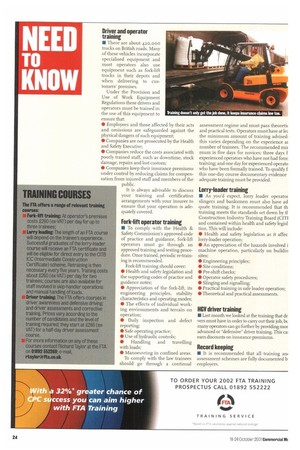Driver and operator training • There are about 420,000 trucks
Page 24

If you've noticed an error in this article please click here to report it so we can fix it.
on British roads. Many of these vehicles incorporate specialised equipment and most operators also use equipment such as fork-lift trucks in their depots and when delivering to customers' premises.
Under the Provision and Use of Work Equipment Regulations these drivers and operators must be trained in the use of this equipment to ensure that: • Employees and those affected by their acts and omissions are safeguarded against the physical dangers of such equipment; • Companies are not prosecuted by the Health and Safety Executive; • Companies reduce the costs associated with poorly trained staff, such as downtime, stock damage, repairs and lost custom; • Companies keep their insurance premiums under control by reducing claims for compensation from injured staff and members of the public.
It is always advisable to discuss your training and certification arrangements with your insurer to ensure that your operation is adequately covered.
Forklift operator training
• To comply with the Health & Safety Commission's approved code of practice and guidance, fork-lift operators must go through an approved training and testing procedure. Once trained, periodic re-training is recommended.
Fork-lift training should cover: • Health and safety legislation and the supporting codes of practice and guidance notes; • Appreciation of the fork-lift, its engineering principles, stability characteristics and operating modes; • The effects of individual working environments and terrain on operation; • Daily inspection and defect reporting; • Safe operating practice; • Use of hydraulic controls; • Handling and travelling with loads; • Manoeuvring in confined areas. To comply with the law trainees should go through a continual assessment regime and must pass theoretic and practical tests. Operators must have at lez the minimum amount of training advised. this varies depending on the experience at number of trainees. The recommended mir mum is five days for novices; three days f experienced operators who have not had forrr training; and one day for experienced operato who have been formally trained. To qualify f this one-day course documentary evidence adequate training must be provided.
Lorry-loader training
II As you'd expect, lorry loader operator slingers and banlcsmen must also have ad quate training. It is recommended that th training meets the standards set down by ti Construction Industry Training Board (CIT1 and contained within health and safety legisl tion. This will indude:
• Health and safety legislation as it affec lorry-loader operation; • An appreciation of the hazards involved i machine operation, particularly on buildin sites; • Engineering principles; • Site conditions; • Pre-shift checks; • Operator safety procedures; • Slinging and signalling; • Practical training in safe loader operation; • Theoretical and practical assessments.
HGV driver training
• Last month we looked at the training that dr vers must have in order to carry out their job, bt, many operators can go further by providing mor advanced or "defensive" driver training. This cal earn discounts on insurance premiums.
Record keeping
• It is recommended that all training an assessment schemes are fully documented b employers.












































































































































